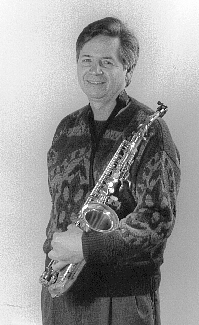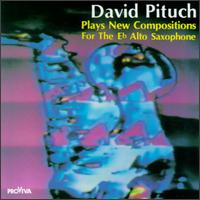 DP:
Pieces mature, it’s true. I’ve noticed this with composers,
too. When you play their works, they say, “Oh, that was
great! That was fantastic!” Then the next time you play it,
in a different situation, they might say, “That was superb. It
was better than I’ve ever heard you play!” So I’m sure there’s a
kind of motivation going on there, too. But pieces that you play
for longer periods of time do mature, and you have a different
understanding of them. My favorite piece, for example, which is
on the first album I ever made called David Pituch Plays, is the Creston Saxophone Sonata. It’s a
piece that’s an old warhorse among professional classical
saxophonists. People don’t even like to record it anymore because
they feel it’s been over-recorded. But I think it’s fabulous to
have the opportunity to play this piece frequently, to record it one
time and a second time and a third time, even! I usually put
about five years of time between recordings. Most record
companies have a policy, too, that if you record something —
like a major piece — then it
shouldn’t be done for at least five, if not ten years more. But
the second time you do it, it’s always different, and usually better
than the first time. It’s not always better, but it will be
different. [Both laugh] Sometimes there are little twists
in it, and other times, if you listen to older recordings versus newer
recordings, you find out that those older recordings weren’t so
bad! Sure, they have their problems, or there are things you
wished you would have done differently. But when you stand back
and just try to listen to it as an entire entity, there’s something
there that clicks. If you’re in a flow, it doesn’t matter what
stage of your career you’re in; there’s going to be something magical
happening.
DP:
Pieces mature, it’s true. I’ve noticed this with composers,
too. When you play their works, they say, “Oh, that was
great! That was fantastic!” Then the next time you play it,
in a different situation, they might say, “That was superb. It
was better than I’ve ever heard you play!” So I’m sure there’s a
kind of motivation going on there, too. But pieces that you play
for longer periods of time do mature, and you have a different
understanding of them. My favorite piece, for example, which is
on the first album I ever made called David Pituch Plays, is the Creston Saxophone Sonata. It’s a
piece that’s an old warhorse among professional classical
saxophonists. People don’t even like to record it anymore because
they feel it’s been over-recorded. But I think it’s fabulous to
have the opportunity to play this piece frequently, to record it one
time and a second time and a third time, even! I usually put
about five years of time between recordings. Most record
companies have a policy, too, that if you record something —
like a major piece — then it
shouldn’t be done for at least five, if not ten years more. But
the second time you do it, it’s always different, and usually better
than the first time. It’s not always better, but it will be
different. [Both laugh] Sometimes there are little twists
in it, and other times, if you listen to older recordings versus newer
recordings, you find out that those older recordings weren’t so
bad! Sure, they have their problems, or there are things you
wished you would have done differently. But when you stand back
and just try to listen to it as an entire entity, there’s something
there that clicks. If you’re in a flow, it doesn’t matter what
stage of your career you’re in; there’s going to be something magical
happening. DP:
It is. And it’s a pearl up there. It’s shiny and it
sparkles, and this gorgeous sound can come out of it. I think
that there’s a new kind of saxophone playing that has evolved over the
past decade, one that’s of extreme precision and very high musicality
with truly outstanding intonation — intonation
that can compete with any other instrument. Because the control
over the saxophone’s intonation is so flexible, I am convinced that a
well-trained musician playing the saxophone can actually play more in
tune than a clarinetist. The clarinetist will have more problems
than a saxophonist.
DP:
It is. And it’s a pearl up there. It’s shiny and it
sparkles, and this gorgeous sound can come out of it. I think
that there’s a new kind of saxophone playing that has evolved over the
past decade, one that’s of extreme precision and very high musicality
with truly outstanding intonation — intonation
that can compete with any other instrument. Because the control
over the saxophone’s intonation is so flexible, I am convinced that a
well-trained musician playing the saxophone can actually play more in
tune than a clarinetist. The clarinetist will have more problems
than a saxophonist. | David
Pituch is an international classical saxophonist based in the Chicago
area. He has been a featured solo artist on Chicago radio stations
WFMT, WNIB, and WBEZ. His live-recital broadcasts have been recorded by
WGBH in Boston, Danish Radio Program 2, Polish Radio, Finnish Radio,
and Austrian Radio. His critically acclaimed solo CD "David Pituch
Plays" (Pro Viva ISPV 175 CD) is available at most major record stores
(Tower Record, Borders Books and Music and from amazon.com). The
Saxophone Journal describes David Pituch as "an outstanding performer
and a wonderful soloist... He is a musical force that must be heard and
a saxophonist that can't be ignored. Concertos premiered by David Pituch include: Concertino by Roman Palester, Musica Concertante by Edward Boguslawski, Concerto by Brian Fennelly, and Concerto by the Chicago composer Robert Kritz. He has performed in recital on the Dame Myra Hess series at the Chicago Cultural Center and the Chautauqua Chicago Series of the Chicago Public Library. Internationally, Mr. Pituch has been a featured soloist on orchestral concerts, recitals, and music festivals throughout all of Europe. As a chamber musician he has performed with the Washington Square Chamber Musicians in New York City and with Muzyka Centrum in Cracow, Poland and Schwaz/Tirol, Austria. Mr. Pituch's performances are consistently described as beautiful programs, thoughtfully designed to demonstrate a broad range of the emergent classical saxophone playing tradition. David Pituch received his musical education at the Baldwin-Wallace College Conservatory in Berea, Ohio (BM); the University of Colorado in Boulder (MM); and at the School of Music at Northwestern University (DM). In April of 1999 Dr. Pituch received an Alumni Achievement Award from the Baldwin-Wallace College Conservatory in recognition of his accomplishments as a performer, promoter, teacher, author, and music historian. |
This interview was recorded in Evanston on June 18, 1998.
Portions
were used (along with recordings) on WNIB ten days later.
This transcription was made and posted on this website in 2009.
To see a full list (with links) of interviews which have been transcribed and posted on this website, click here.
Award - winning broadcaster Bruce Duffie was with WNIB, Classical 97 in Chicago from 1975 until its final moment as a classical station in February of 2001. His interviews have also appeared in various magazines and journals since 1980, and he now continues his broadcast series on WNUR-FM, as well as on Contemporary Classical Internet Radio.
You are invited to visit his website for more information about his work, including selected transcripts of other interviews, plus a full list of his guests. He would also like to call your attention to the photos and information about his grandfather, who was a pioneer in the automotive field more than a century ago. You may also send him E-Mail with comments, questions and suggestions.